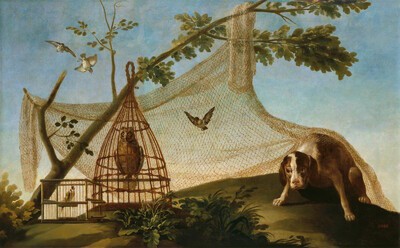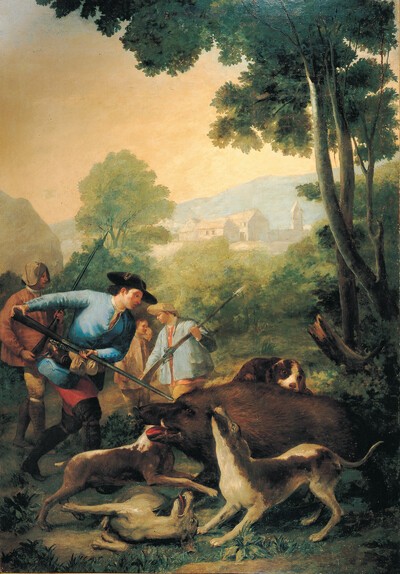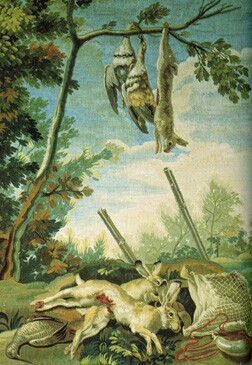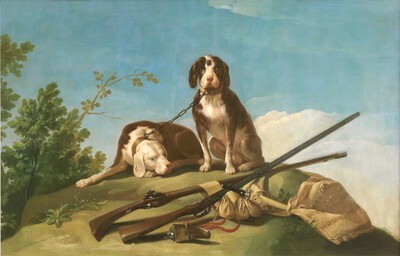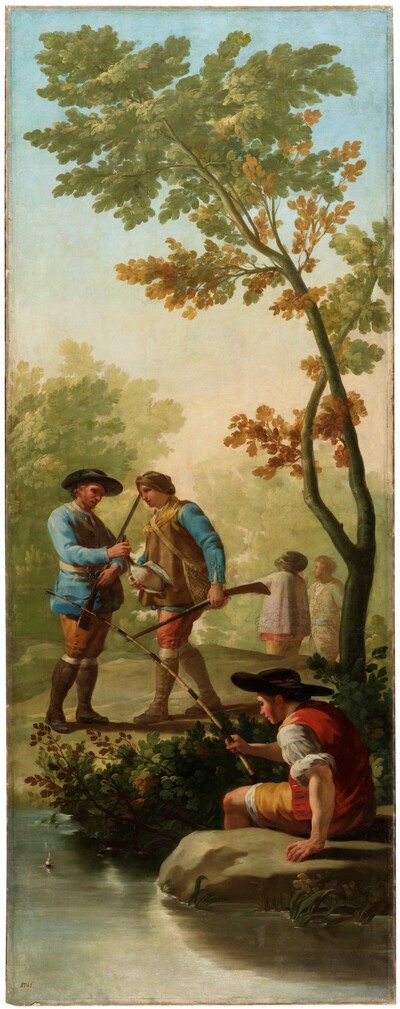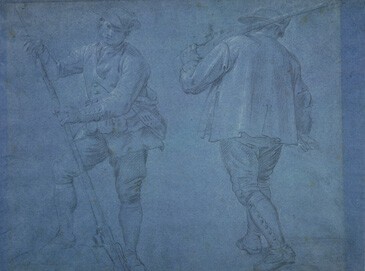- Cronología
- 1775
- Ubicación
- The Prado National Museum. Madrid, Madrid, Spain
- Dimensiones
- 262 x 71 cm
- Técnica y soporte
- Oil on canvas
- Reconocimiento de la autoría de Goya
- Documented work
- Titular
- El Prado National Museum
- Ficha: realización/revisión
- 05 Nov 2009 / 14 Jun 2023
- Inventario
- (P00805)
- Otros títulos:
-
Hunter and Two Dogs (El cazador y dos perros)
Hunter with Dogs (Cazador y los perros)
Hunter with Greyhound (Cazador con lebrel)
For the history of the whole series, see Wild Boar Hunt.
In addition to the different attributions made in relation to this series of cartoons and the documentation of Goya's authorship made by Sambricio, the work before us was also attributed to Zacarías González Velázquez by Vicente López in the inventory that he carried out in 1834 for Ferdinand VII's will.
Around 1856 or 1857, this piece was moved from the Royal Tapestry Factory of Santa Bárbara to the Royal Palace in Madrid, and from there it became part of the collection of the Prado Museum in 1870 (still with the attribution to Ramón Bayeu).
With his back to the viewer and a shotgun over his shoulder, a hunter grasps the leash of two dogs. A wooded landscape is seen in the background.
The finished tapestry also features another hunter, on horseback, who is only visible in the canvas to the more observant spectator, having been overpainted with bushes. We do not know who did this, nor when, although Sambricio points out that it must have been around 1830, when the second tapestry was woven, since in the first one the rider clearly appears. Arnaiz observed that it may have been Goya himself who removed the rider when he saw the imbalance of the composition.
Of all the cartoons that made up the first delivery of this series, Sambricio is of the opinion that this is the most Goya-esque because of the naturalism of the main figure, whilst other writers insist that the characteristics imposed by the director of the commission, Francisco Bayeu, carry more weight than those of Goya.
There exists a preparatory drawing for the hunter who is leading the dogs, in which he is accompanied by another figure who appears in the cartoon Hunter Loading his Shotgun, which suggests that Goya made these studies from life and later included them in the two compositions, hence the realism observed by Sambricio.
-
Goya. 250 AniversarioMuseo Nacional del PradoMadrid1996consultant editor Juan J. Luna. From March 29th to June 2nd 1996cat. 4
-
Permanencia de la memoria, cartones para tapiz y dibujos de GoyaMuseo de ZaragozaZaragoza1997organized by Gobierno de Aragón, Museo Nacional del Prado and Patrimonio Nacional, consultant editor Fernando Checa Cremades. From February 14th to April 6th 1997cat. 4, sec. IV
-
Goya en Madrid. Cartones para tapices 1775-1794Museo Nacional del PradoMadrid2014p. 69
-
Tapices de GoyaMadridPatrimonio Nacional1946pp. 49, 52-53, 55, 61-62, 67, 151, 192,
-
Vie et ouvre de Francisco de GoyaParísOffice du livre1970pp. 74, 85, cat. 61
-
BarcelonaPolígrafa1970vol. I, p. 243, cat. 55
-
L’opera pittorica completa di GoyaMilanRizzoli1974p. 92, cat. 51
-
Francisco de Goya, cartones y tapicescol. col. "Espasa Arte"Espasa Calpe1987pp. 46, 50-54, 64, 83, 237, cat. 5C y p.
-
Francisco de Goya, 4 vols.ZaragozaCaja de Ahorros de Zaragoza, Aragón y Rioja1980-1982vol. I, pp. 76-77
-
Francisco de Goya. Los cartones para tapices y los comienzos de su carrera en la corte de Madridcol. col. "Ensayos de Arte Cátedra"MadridCátedra1987p. 43
-
Goya. 250 AniversarioMadridMuseo del Prado1996p. 282-283, cat. 4 y p. 68 (il.)
-
Goya en Madrid. Cartones para tapices 1775-1794MadridMuseo Nacional del Prado2014p. 69

